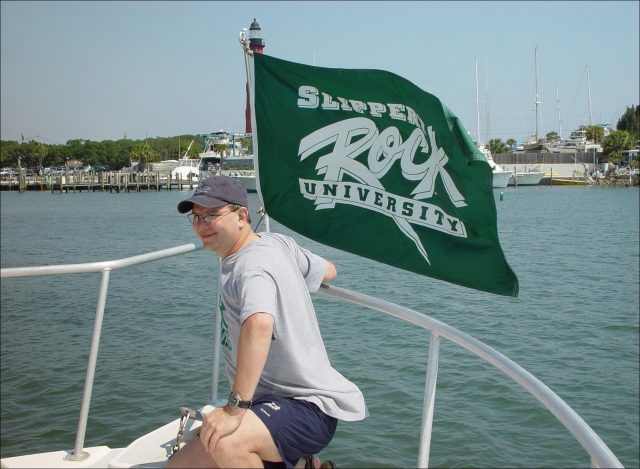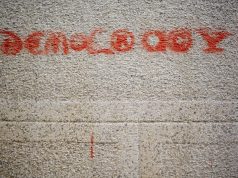Students in Robert Ogoreuc’s PE 349: Skin and Scuba Diving class are intent on mastering the basics of diving in the Slippery Rock University pool this semester.
The assistant professor of physical and health education has been on a 2002 wreck dive that combined the disciplines of oceanography, cartography and literary history off the coast of Florida.
Along with fellow diver and Middlesex Township police officer Conrad Pfeifer, Ogoreuc said he helped map the debris field of the Commodore, a steamship that sank in 1897 and that helped inspire a short story by a famous American writer.
“The Commodore was running guns and ammunition to Cuba,” said Ogoreuc.
It was also carrying 25-year-old author Stephen Crane who was trying to get to Cuba and report on the Cubans’ rebellion against Spain.
Damaged after striking a sandbank, the Commodore sprang a leak on New Year’s Day 1897, and came to a stop about 16 miles from the present-day Ponce de Leon Inlet.
The ship sank on Jan. 2, and Crane and three other men were the last to abandon ship. They spent a day and a half in heavy seas struggling to land their lifeboat at Daytona Beach.
The small boat, however, overturned in the surf, forcing the exhausted men to swim ashore; one of them died.
Ogoreuc said, “Crane later wrote a story, ‘The Open Boat,’ about the incident.”
The Ponce de Leon Inlet Lighthouse Preservation Association became interested in the wreck due to its connection with the historic light station.
In 2001, PILPA joined with the Cambrian Foundation to conduct the first systematic archaeological survey of the wreck site.
This organization of technical divers, under the direction of archaeologist Kimberly Eslinger, implemented three seasons of archaeological investigation in 2002-2004, to document the exposed remains.
In 2002, Ogoreuc and Pfeiffer, experienced wreck divers, joined the effort for a week.
“We were brought on board by the Cambrian Foundation,” said Ogoreuc. “We worked out of the lighthouse.”
Pfeifer said, “I have been on other expeditions. This was an easy one compared to say, the Monitor.”
Pfeifer was one of a select number of divers permitted to document and dive the ruins of the Civil War ironclad, USS Monitor. He had been involved with the survey and recovery of the propeller, engine and smaller artifacts from 1995 to 2001.
In the Commodore effort, Ogoreuc said most of his dives were concerned with mapping the wreck, with special emphasis of the location of significant debris.
“We established a baseline and then ran a midline down the center of the wreck,” said Ogoreuc. “We mapped out anything we found, bullets, shells, and measured them onto a big table map set up in the lighthouse.”
Ogoreuc said the wooden parts of the Commodore had long since rotted away leaving only its metal fittings and cargo.
Divers were able to spot the propeller shaft and boiler, he said.
“It was more of a debris field than a shipwreck,” he said. “It was a very unique opportunity to be on a historic dive.”
The wreck was about 15 miles off the coast of Daytona Beach, he said.
“It was in about 75 feet of water. It wasn’t super deep but we used enriched air (with a higher oxygen percentage), so we could stay longer on the bottom,” said Ogoreuc. Members of the two-man dive teams also used double scuba tanks and carried back-up regulators.
Most dives lasted no more than an hour, he said.
Ogoreuc said, “I got started diving in 1985. Conrad and I have dived since the ’80s.”

















